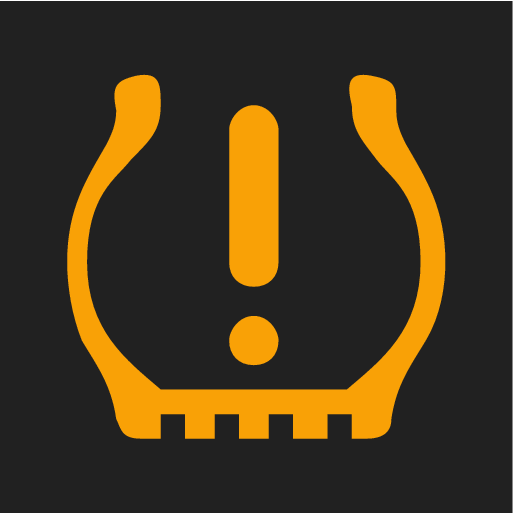TPMS uses sensors mounted in the tire valves to check inflation pressure levels. When the vehicle is moving at a speed of approximately 20 mph (30 km/h) or faster, these sensors transmit inflation pressure data to a receiver located in the vehicle. If inflation pressure is too low, an indicator symbol will illuminate in the instrument panel and a text message will be displayed.
| Symbol | Explanation |
|---|---|
 | The symbol illuminates to indicate low tire inflation pressure. If a malfunction occurs in the system, the tire pressure warning symbol will flash for approximately 1 minute and then remain illuminated. |
Each tire, including the spare (if provided), should be checked monthly when cold and inflated to the inflation pressure recommended by the vehicle manufacturer on the vehicle placard or tire inflation pressure label. (If your vehicle has tires of a different size than the size indicated on the vehicle placard or tire inflation pressure label, you should determine the proper tire inflation pressure for those tires.)
As an added safety feature, your vehicle has been equipped with a tire pressure monitoring system (TPMS) that illuminates a low tire pressure telltale when one or more of your tires is significantly under-inflated. Accordingly, when the low tire pressure telltale illuminates, you should stop and check your tires as soon as possible, and inflate them to the proper pressure.
Driving on a significantly under-inflated tire causes the tire to overheat and can lead to tire failure. Under-inflation also reduces fuel efficiency and tire tread life, and may affect the vehicle's handling and stopping ability. Please note that the TPMS is not a substitute for proper tire maintenance, and it is the driver's responsibility to maintain correct tire pressure, even if under-inflation has not reached the level to trigger illumination of the TPMS low tire pressure telltale.
Your vehicle has also been equipped with a TPMS malfunction indicator to indicate when the system is not operating properly. The TPMS malfunction indicator is combined with the low tire pressure telltale.
When the system detects a malfunction, the telltale will flash for approximately one minute and then remain continuously illuminated. This sequence will continue upon subsequent vehicle start-ups as long as the malfunction exists. When the malfunction indicator is illuminated, the system may not be able to detect or signal low tire pressure as intended.
TPMS malfunctions may occur for a variety of reasons, including the installation of replacement or alternate tires or wheels on the vehicle that prevent the TPMS from functioning properly. Always check the TPMS malfunction telltale after replacing one or more tires or wheels on your vehicle to ensure that the replacement or alternate tires and wheels allow the TPMS to continue to function properly.
Messages in the instrument panel
When the TPMS symbol illuminates, the following text messages may also be displayed:
- Tire pressure low: the tire(s) affected will also be specified.
- Tire needs air now: the tire(s) affected will also be specified.
- Tire pressure system Service required.
If TPMS cannot determine which tire(s) have low inflation pressure, general messages may be displayed, such as:
- Tire pressure low Check tires
- Tire needs air now Check tires
TPMS sensors can be installed on the valve hole area, on the factory-installed wheels as well as on optional ones.
If a spare wheel or other wheel without a TPMS sensor is used, a fault message will appear in the instrument panel after driving for a few minutes.
After changing wheels, always check that the new wheels have TPMS sensors to avoid a system malfunction warning.
TPMS does not replace the need for regular tire inspection and maintenance.
Recommendations
TPMS sensors should be mounted on all wheels used with the vehicle, including winter wheels.
Note
- If you change to tires with a different dimension than the factory-installed ones, the TPMS system must be reconfigured for these tires. This must be done by a trained and qualified Volvo service technician.
- If a tire is changed, or if the TPMS sensor is moved to another wheel, the rubber valve and valve core should be replaced.
- When installing TPMS sensors, the vehicle must be parked for at least 15 minutes with the ignition off. If the vehicle is driven within 15 minutes, a TPMS error message will be displayed.